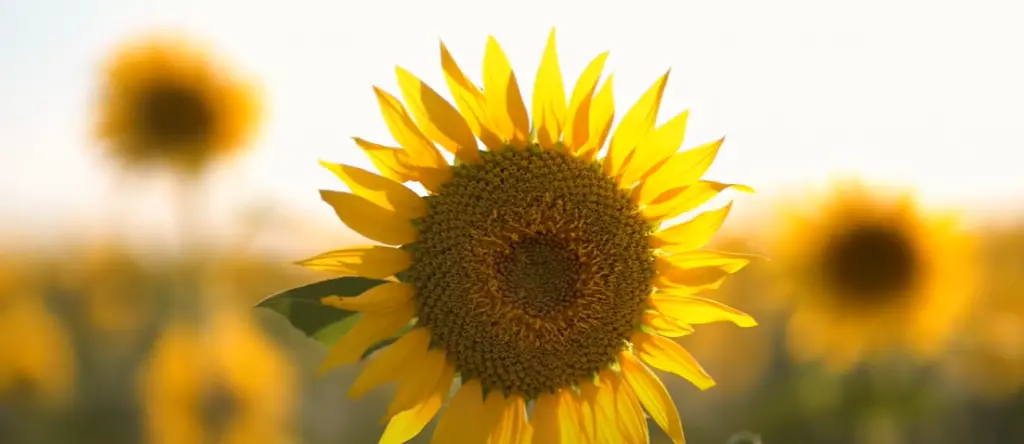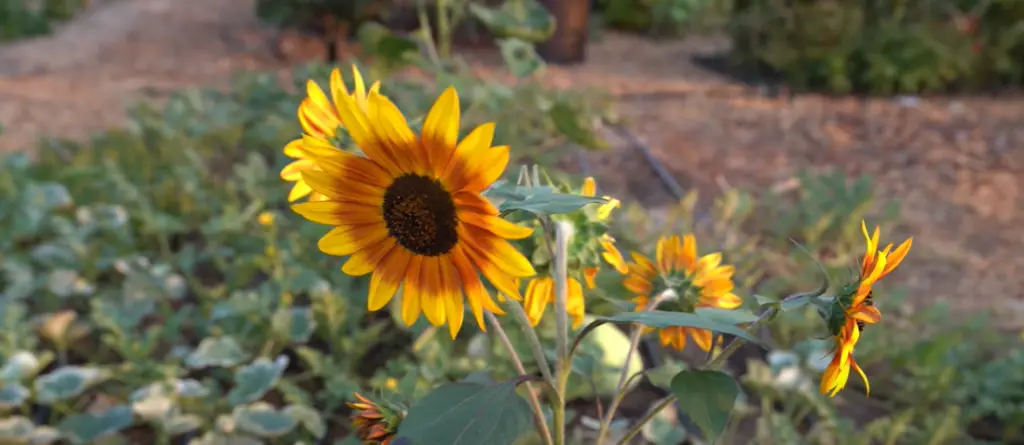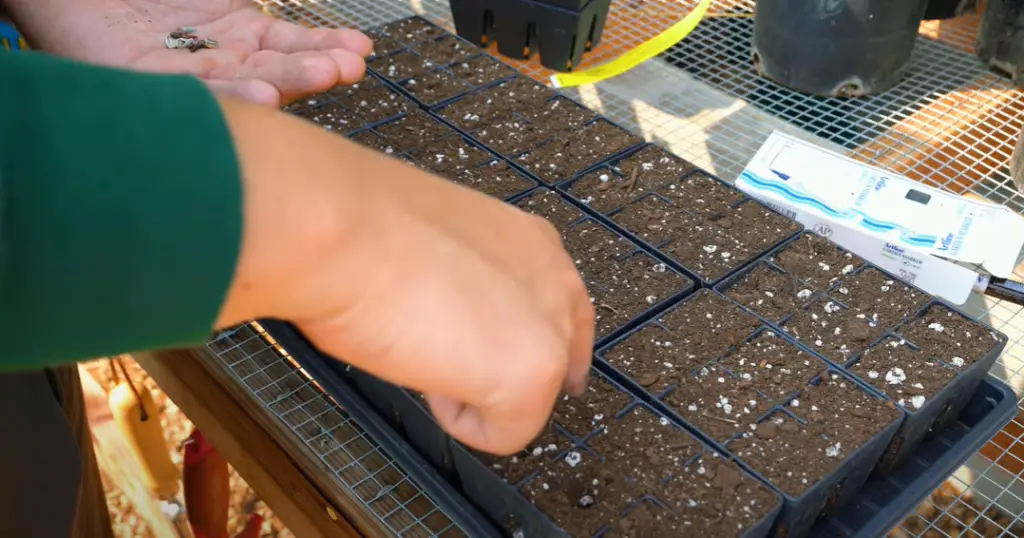Are you hoping to add a splash of color to your garden this summer? Sunflowers are incredibly popular for their beauty, and they can be an incredibly rewarding plant to grow. But when should you start planting sunflower seeds so that they thrive in your outdoor space? In this blog post, we’ll delve into the ideal times and weather conditions for planting sunflower seeds, as well as how to take care of them after planting so that you can enjoy a beautiful crop of sunflowers all season long!
What Are the Special Characteristics of Sunflowers?
Sunflowers are beloved plants, not only for their charm and beauty but also for the unique characteristics that they possess. Sunflowers are tall and can reach heights of up to 3 meters if left unharvested. They have a distinct yellow color which is usually bright and cheerful and helps attract pollinators such as bees. [1]
Their leaves grow in an alternating pattern in the stem, which grows from the center of the plant. The leaves are broad and usually have a pointed tip. Additionally, sunflowers will produce large seed heads at the top of their stems, ranging in size depending on variety.
Sunflowers are also known to have an extensive root system which helps them absorb nutrients from the soil. On average, they can reach depths of up to 6 feet in just the first year! This makes them ideal for areas that suffer from drought or poor soil quality.
Not only are sunflowers attractive to look at, but they also provide an important source of food for both humans and wildlife alike. Their seeds can be harvested and eaten either raw or roasted, while their nectar provides vital sustenance for bees and other pollinators. [2]

What are the Benefits of Growing Sunflowers?
Sunflowers are always a crowd-pleaser and can be a great addition to any outdoor space. They’re colorful, versatile, and easy to care for. Plus, they provide many benefits beyond just their beauty. Here are some of the top reasons why you should consider growing sunflowers:
- Sunflowers help attract beneficial insects. Bees, butterflies, and other pollinators are attracted to the bright yellow petals of sunflowers, making them an excellent addition to your garden if you want to support a healthy ecosystem in your outdoor space. [3]
- Sunflowers can provide shade from the hot summer sun. By planting sunflowers along the perimeter of your yard or garden, you can create a natural shade barrier that will help protect your plants from the intense heat of summer days.
- Sunflowers are drought-tolerant. Sunflowers need very little water to thrive, making them an ideal choice for gardens in areas prone to long periods of drought and dry summers.
- Sunflowers provide food for wildlife. Sunflowers are a great source of food for animals like birds and small mammals, so if you’re looking to attract wildlife, sunflowers can be an excellent addition to your garden!
- Sunflowers provide a natural windbreak. If you have a garden in an area prone to strong winds, planting sunflowers along the edges of your plot can help to provide a natural barrier that will protect your other plants from being blown away. [4]
10 Popular Types of Sunflowers to Grow
There are many types of sunflowers that can be grown, so it’s important to choose the right type for your garden. Here are some popular varieties of sunflowers you may want to consider:
- Teddy Bear Sunflower: This variety is known for its large, bright yellow flowers and a unique fuzzy texture that looks like a teddy bear. They are easy to grow and can reach heights of up to 12 feet tall! [5]
- Mammoth Sunflower: This is the classic sunflower that made this flower so popular, with large showy yellow blooms. Mammoth Sunflowers can reach heights of up to 15 feet tall and will produce 1-2 bushels of seeds each season.
- Autumn Beauty Sunflower: This variety is perfect for those who want to harvest sunflower seeds but don’t have the space. These plants will reach heights of up to 4 feet and produce an abundance of small, edible black seeds.
- Evening Sun Sunflower: This variety has unique dark orange flowers that open in the evening, making them a great addition to any evening garden. They are also cold-tolerant and can survive in temperatures as low as 10 degrees Fahrenheit.
- Soraya Sunflower: This sunflower variety is known for its huge, bright red blooms that can reach heights of up to 8 feet tall. They are also very disease resistant and make a great addition to any garden.
- Sungold Sunflower: This variety is a dwarf sunflower, reaching heights of up to 3 feet tall and producing plenty of bright yellow blooms. They are perfect for those who don’t have the space for larger varieties.
- Lemon Queen Sunflower: This sunflower produces unique lemon-scented yellow blooms that can reach heights of up to 6 feet tall. It is also very tolerant of drought and heat, making it a great choice for hotter climates.
- Red Sun Sunflower: This variety produces bright red flowers that can reach heights of up to 4 feet tall. They are perfect for adding a splash of color to any outdoor space!
- Autumn Beauty Mix Sunflower: This sunflower mix is perfect for those who want to experience the beauty of the autumn sunflower season without having to worry about harvesting seeds. The mix includes Evening Sun, Mammoth, and Sungold varieties, giving you a variety of hues and sizes in one package.
- Sunzilla Sunflower: This variety produces huge flowers up to 12 inches wide that can reach heights of up to 8 feet tall! They are also very drought-tolerant and will continue blooming throughout the season.
No matter which variety of sunflower you choose, they are sure to bring a bright and cheerful touch to your garden. Plus, their deep roots help them absorb more nutrients from the soil, making them an excellent choice for areas with poor soil quality. [6]

How to Select Seeds for Planting Sunflowers?
Sunflowers are a beautiful addition to any garden. But when it comes to choosing the right type of sunflower seed for planting, there are a few key things to consider that can help you select the best variety for your needs.
First, look at the climate in which you intend to plant your sunflower seeds. Some varieties are more heat-tolerant than others and may require more watering in hot, dry climates. It’s also important to consider the length of the growing season for your area; some varieties will thrive with longer days while others will do better with shorter ones.
You should also take into account how much time you have to dedicate to sunflower maintenance. While most sunflower varieties require minimal care, some require more frequent watering or staking in order to produce large blooms. If you’re short on time or want a low-maintenance variety, look for sunflower seeds that are classified as “low-maintenance”.
Focus on your personal preferences when it comes to the look and feel of your garden. Some varieties produce large blooms with bright colors, while others are more subtle in their appearance. Selecting a sunflower type that complements the existing foliage in your garden is always a good way to go.
With this information, you’ll be able to find the right type of sunflower seed for your garden. Don’t forget to check the expiration date on each bag since old seeds are less likely to germinate and grow. For more tips on how to successfully plant sunflowers, visit your local gardening store or consult an expert! [7]

How to Grow Sunflowers?
Sunflowers are beautiful, easy to maintain flowers that can bring a bit of cheer and brightness to any garden. Growing these majestic blooms is relatively simple, but there are a few steps you should take in order to ensure the best possible results. Here’s how to get started:
- Pick the right time of year – Sunflower seeds need to be planted in the late spring or early summer, when the soil has warmed up and the threat of frost is over.
- Find a sunny spot – As their name implies, sunflowers need plenty of sunshine, so make sure your chosen planting location is getting at least 6-8 hours of direct sunlight each day.
- Prepare the soil – Sunflowers thrive in well-draining, loose soil that is enriched with organic compost or fertilizer. Make sure to till the soil before planting.
- Plant your seeds – It’s best to plant sunflower seeds about 1/2 an inch deep and spaced about 6 inches apart from each other. Cover lightly with dirt and water generously, making sure to keep the soil moist.
- Fertilize – Once your plants have grown to about 6-8 inches in height, begin fertilizing them with a high nitrogen fertilizer every 4-6 weeks throughout the growing season.
- Monitor for pests and diseases – Keep an eye out for common sunflower pests such as aphids or spider mites, and diseases such as powdery mildew.
- Harvest – Sunflowers can be harvested when the back of the flower head begins to turn yellow, usually about 67-90 days after planting. Cut stems, hang upside-down, and allow to dry before storing or using in arrangements. [8]
When to Plant Sunflower Seeds?
This is one of the most common questions asked by gardeners and flower enthusiasts alike. Sunflower seeds are a popular choice for a variety of reasons, from their vibrant colors to their nutritious benefits. Planting them at the right time can mean the difference between success and failure.

There are several factors to consider when determining when to plant sunflower seeds. They cover:
Weather conditions
Weather conditions play a major role in the success of sunflower seeds. The temperature needs to be warm enough for the seeds to germinate and grow, but not too hot that they will dry out and die. Generally speaking, most areas require temperatures between 65 – 85°F (18-30°C) for optimal growth. It’s also important to note that during germination, temperatures should remain consistent. So if you’re in an area with fluctuating weather, it’s best to wait until the temperature is more stable before planting your sunflower seeds.
Soil conditions
The soil conditions are another important factor to consider when planting sunflower seeds. The soil needs to be well-draining and nutrient rich for sunflowers to thrive. You should also check the pH level of your soil, as sunflowers prefer soil with a pH between 6 and 8. If the pH is too low or too high, you may need to supplement the soil with fertilizer or lime in order to raise or lower the pH levels.
Sunlight
Sunflower seeds need plenty of sunlight in order to germinate and grow. If you’re planting them in an area with limited sun exposure, such as a porch or balcony, then it’s best to wait until the summer months for optimal growth. Sunflowers need around 8 hours of direct sunlight per day in order to reach their full potential.
Planting time
The ideal time to plant sunflower seeds depends on your local climate and weather conditions. In general, it’s recommended to wait until the last frost has passed before planting sunflower seeds. This usually occurs in late spring or early summer. It’s also important to consider the length of time between planting and harvesting, as some varieties can take up to 120 days from seed-to-harvest.
Location
The location of your sunflower plants is also crucial to their growth and development. Sunflowers need at least 4-6 feet between each plant in order to reach their full potential. Also, make sure to plant them in an area that receives plenty of direct sunlight throughout the day, as this will ensure optimal blooming and growth. [9]

How to Care for Sunflowers?
Sunflowers are beautiful and cheerful flowers that bring a lot of joy to our gardens. When cared for correctly, sunflowers can blossom with vibrant yellow petals and stunning brown centers. To ensure success in growing your own sunflower patch, here are some tips on how to properly care for them:
Planting Sunflowers
Sunflowers thrive in the sun, so it’s important to choose a location with plenty of sunlight. If possible, select an area that gets direct sunlight for at least 8 hours each day. The best time to plant sunflower seeds is in early spring after all the threat of frost has passed. Make sure to water your seedlings regularly and keep them well-watered throughout the growing season.
Fertilizing Sunflowers
Fertilize your sunflower plants every 4-6 weeks while they are actively growing. Choose a fertilizer that is specifically designed for flowering plants and follow the instructions on the package. This will help to ensure that your sunflowers receive all of the nutrients they need to thrive.
Deadheading Sunflowers
Deadheading sunflowers is an important part of keeping them healthy and blooming for longer periods of time. When the petals start to fade, snip off the dead flowers as close to the stem as possible. This will stimulate new growth and encourage your sunflowers to produce even more vibrant blooms.
Staking Sunflowers
As your sunflower plants grow, they may need to be staked to help keep them upright. Choose a sturdy stake that is tall enough to support the plant and drive it into the ground at least 2-3 inches away from the stem. If you are using multiple stakes, make sure that they are spaced evenly apart. Wrapping twine around the stakes and plant will also help keep your sunflowers in place.
Winter Care
In areas with cold winters, it is important to provide extra protection for your sunflower plants. Spread a layer of mulch around the base of each plant to help insulate them from the cold temperatures. If you live in an area with extreme winter weather, it may be necessary to cover your sunflowers with a layer of burlap or plastic. [10]
How to Harvest Sunflower Seeds?
Harvesting sunflower seeds is a fun and rewarding activity that can be enjoyed by the whole family. Here are some steps to help you harvest your own sunflower seeds:
- Wait until the flower petals start to dry out and fall off. Check for color, texture and size of the seeds to determine when they are ready for harvesting.
- Cut off the head of the sunflower plant, taking care not to damage any of the seeds. Be sure to wear gloves while you are doing this!
- Place the cut off head on a piece of newspaper or other clean surface and gently brush away any dirt or debris.
- Place the sunflower seeds into a large bowl and rub your hands over them to remove any remaining husks.
- Lay the sunflower seeds out in an even layer on a baking sheet and allow them to dry for several days, or until they are no longer sticky.
- Once the sunflower seeds have dried, you can store them in an airtight container in a cool and dry place. Enjoy! [11]
Common Problems With Sunflowers
Sunflowers are a popular choice among gardeners, and it’s easy to see why. They can add a splash of color to any garden and bring life wherever they grow. But there are some common problems that sunflower growers should be aware of when planting sunflower seeds.
Tardiness
The first problem is tardiness. Sunflowers require a long time to grow and flower, meaning that they should be planted early in the growing season. If you plant your sunflower seeds too late in the season, then there’s a chance that they won’t bloom until the following year.

Poor Pollination
Sunflowers are also prone to poor pollination, which can result in a lack of blooms. To ensure that your sunflower plants get enough pollen, make sure you plant them near other varieties of flowers so that the bees can easily fly between them.
Pest Infestation
Another potential issue is pest infestation. Sunflowers are a favorite snack for hungry critters, such as caterpillars, beetles, and even birds. Make sure to regularly check your sunflower plants for signs of pests and take appropriate measures to prevent their spread.
Poor Soil Conditions
Sunflowers need well-drained soil in order to grow properly. If the soil is too soggy or overly acidic, then your sunflower plants may not thrive. Make sure to test your soil before planting and take any necessary steps to improve its nutrition and water-retentiveness. [12]
FAQs
What is the best month to plant sunflower seeds?
The best month for planting sunflower seeds is typically in the summer months, such as June or July. Planting earlier can help to ensure that your sunflowers have enough time to fully mature before cold weather sets in. Sunflowers are also able to tolerate some frost and can still be planted later in the fall season.
Should I soak sunflower seeds before planting?
Soaking sunflower seeds before planting can help to speed up the germination process, but it’s not necessary. Sunflower seeds contain a hard seed coat and need plenty of warmth and moisture in order to germinate. If you choose to soak your sunflower seeds overnight before planting, make sure they’re completely submerged in water. Immediately after soaking, transplant the sunflower seeds into a container with moist soil so they can begin to germinate.
How long does it take to fully grow a sunflower from seed?
Sunflowers are fast-growing plants, and some varieties can reach full maturity in as little as 70 days! However, depending on what variety you plant and the season in which you plant it, the growth process of your sunflower may take anywhere from 60 days to 120. While different types of sunflowers have different maturity rates, if you want to guarantee yourself a blooming sunflower, make sure you plant the seeds at least 120 days before your first frost.
How long do sunflowers last?
It depends on the type of sunflower you choose. Annual varieties tend to live for one season, while perennial kinds can last up to three years in the right environment. Either way, it is important to select the right variety for your location and climate conditions, and then follow the planting instructions carefully to ensure healthy growth.
Useful Video: How to Grow Sunflowers Successfully At Home
To Sum Up
To sum it up, the best time to plant sunflower seeds is in early spring or late summer. No matter when you decide to plant them, ensure your soil is nutrient-rich and make sure to provide plenty of sunlight and water as the plants grow and mature. Have fun with experimenting and let your creative side guide you when selecting what type of sunflower seeds to use based on height, variety of colors, or how many blooms per stalk. If you are looking into more unique options for your garden beds there are small potted versions available too! So get ready for a whole new season of beaming colors and think ahead about a beautiful future filled with colorful blooms this upcoming spring. With some proper planning now throughout the cold winter months, you’ll be able to make memories with visiting bees and the beauty of your own personally planted sunflower gardens in just a few months time!
References:
- https://www.kew.org/plants/sunflower
- https://verbeekenbol.com/en/news/helianthus-annuus/
- https://www.bountifulgardener.com/5-benefits-of-growing-sunflowers/
- https://themicrogardener.com/5-benefits-reasons-to-grow-sunflowers/
- https://gardenerspath.com/plants/flowers/best-sunflower-varieties/
- https://www.countryliving.com/gardening/g32128958/sunflower-types/
- https://www.wikihow.com/Grow-a-Sunflower-in-a-Pot
- https://www.thepioneerwoman.com/home-lifestyle/gardening/a40261260/how-to-grow-sunflowers/
- https://www.gardenersworld.com/how-to/grow-plants/how-to-grow-sunflowers/
- https://www.almanac.com/plant/sunflowers
- https://www.americanmeadows.com/content/harvest-sunflower-seeds-planting-roasting-feeding-birds
- https://morningchores.com/sunflower-pests-and-diseases/










Leave a Reply
View Comments